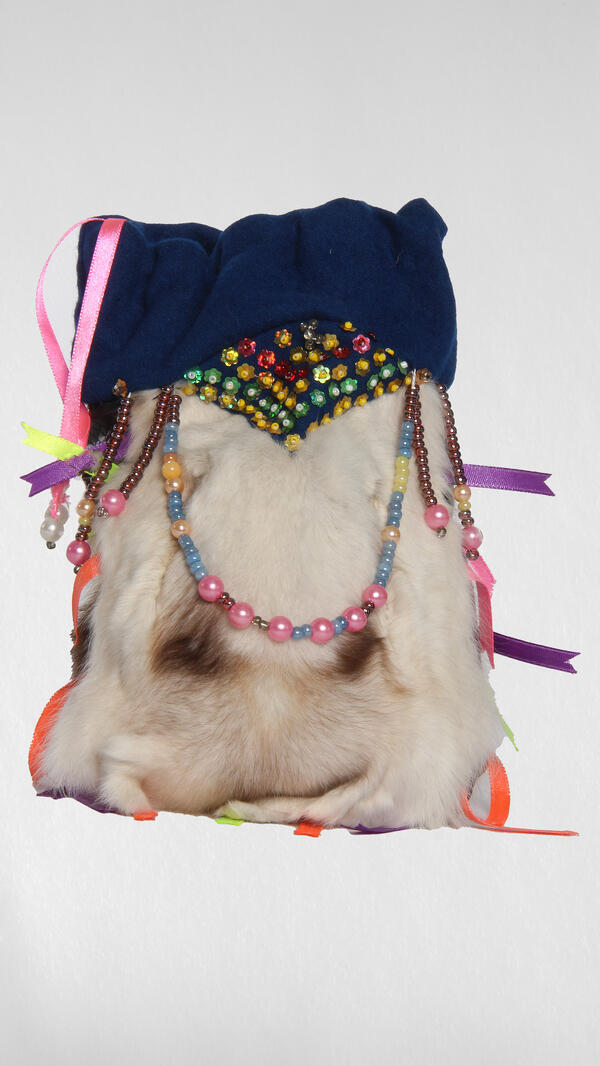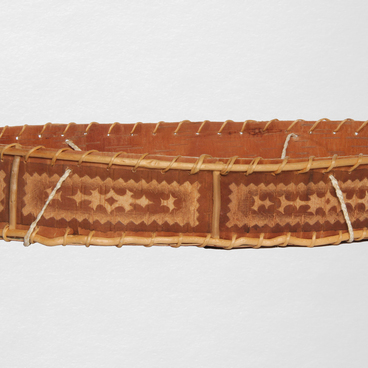In a fur bag, or in a fur sack, the inhabitants of the tundra stored and transported household belongings: clothes, tools, handicrafts, religious objects and much more.
Initially, fur bags were sewn from fox, arctic fox, beaver, squirrel, marten, sable, ermine skins. The peoples who roamed the coast used the skins of seals or nerpa for sacks. Parts of the product were connected to each other using animal tendon threads.
Sacks made from kamus — the hide from the lower part of a deer’s legs — as well as from the hide from the foreheads of deer, gradually became popular. This was due to the development of large-scale reindeer husbandry in the tundra.
There were three main types of Nenets bags: pad, tutsya (tucheyka) and padko.
Padko was the smallest bag. It was tied with a pair of leather strings. Cloth, tendon threads, buttons, small household items were stored in the padko.
The pad was a large and horizontally elongated bag. It was closed with the help of paired straps made of rovduga — tanned leather. Clothes, fur shoes for women and men, skins of fur animals were kept in the pad. Sometimes wood shavings, fur rags, bird feathers were put into it. Usually the bag served for a long time — up to 40-50 years.
The tutsya was a small vertical oval bag. From above, it was closed by pulling a leather strap threaded through the holes in upper part of the bag. Women used this bag to store sewing accessories: pieces of leather, tendon threads, and scissors. A woman always had a tutsya by her side, so the bag wore out very quickly. The museum collection exhibits just this type of a handicraft bag.
To make a tutsya, two pieces of deerskins removed from the head (forehead) of a deer were needed. They were sewn with a strip of fur or rovduga. It also formed the sides, bottom and mouth of the bag. The bottom corners of the bag were rounded.
In contrast to the pad, both the front and back walls of the tutsya were decorated. The front was light and the back was dark. The ornament was inserted the same on both sides, but made it contrasting. The most common pattern was geometric, which was sewn from pieces of white and dark fur. These could be “heads” — a line of triangles with the top turned downward, patterns composed of oblique crosses and meaning “deer antlers”, and others. Strips of colored cloth were often inserted into the seams. The mouth of the bag was not decorated.
The eye holes on the deer’s foreheads were sewn up with strips of fur and trimmed. The preferable colors were red, yellow, and green. Sometimes, triangles of fur with strips of cloth were inserted in the place of the eye sockets. Tassels were sewn along the edges of the bag as a talisman against blindness and deafness.
Initially, fur bags were sewn from fox, arctic fox, beaver, squirrel, marten, sable, ermine skins. The peoples who roamed the coast used the skins of seals or nerpa for sacks. Parts of the product were connected to each other using animal tendon threads.
Sacks made from kamus — the hide from the lower part of a deer’s legs — as well as from the hide from the foreheads of deer, gradually became popular. This was due to the development of large-scale reindeer husbandry in the tundra.
There were three main types of Nenets bags: pad, tutsya (tucheyka) and padko.
Padko was the smallest bag. It was tied with a pair of leather strings. Cloth, tendon threads, buttons, small household items were stored in the padko.
The pad was a large and horizontally elongated bag. It was closed with the help of paired straps made of rovduga — tanned leather. Clothes, fur shoes for women and men, skins of fur animals were kept in the pad. Sometimes wood shavings, fur rags, bird feathers were put into it. Usually the bag served for a long time — up to 40-50 years.
The tutsya was a small vertical oval bag. From above, it was closed by pulling a leather strap threaded through the holes in upper part of the bag. Women used this bag to store sewing accessories: pieces of leather, tendon threads, and scissors. A woman always had a tutsya by her side, so the bag wore out very quickly. The museum collection exhibits just this type of a handicraft bag.
To make a tutsya, two pieces of deerskins removed from the head (forehead) of a deer were needed. They were sewn with a strip of fur or rovduga. It also formed the sides, bottom and mouth of the bag. The bottom corners of the bag were rounded.
In contrast to the pad, both the front and back walls of the tutsya were decorated. The front was light and the back was dark. The ornament was inserted the same on both sides, but made it contrasting. The most common pattern was geometric, which was sewn from pieces of white and dark fur. These could be “heads” — a line of triangles with the top turned downward, patterns composed of oblique crosses and meaning “deer antlers”, and others. Strips of colored cloth were often inserted into the seams. The mouth of the bag was not decorated.
The eye holes on the deer’s foreheads were sewn up with strips of fur and trimmed. The preferable colors were red, yellow, and green. Sometimes, triangles of fur with strips of cloth were inserted in the place of the eye sockets. Tassels were sewn along the edges of the bag as a talisman against blindness and deafness.



